Image Monitoring of Pharmaceutical Blending Processes and the Determination of an End Point by Using a Portable Near-Infrared Imaging Device Based on a Polychromator-Type Near-Infrared Spectrometer with a High-speed and High-Resolution Photo Diode Array Detector
Abstract
:1. Introduction
2. Results and Discussion
2.1. NIR Spectra of Ascorbic Acid, D-mannitol and Magnesium Stearate
2.2. Evaluation of Inhomogeneity during Blending Process by In-Line NIR Spectrometer
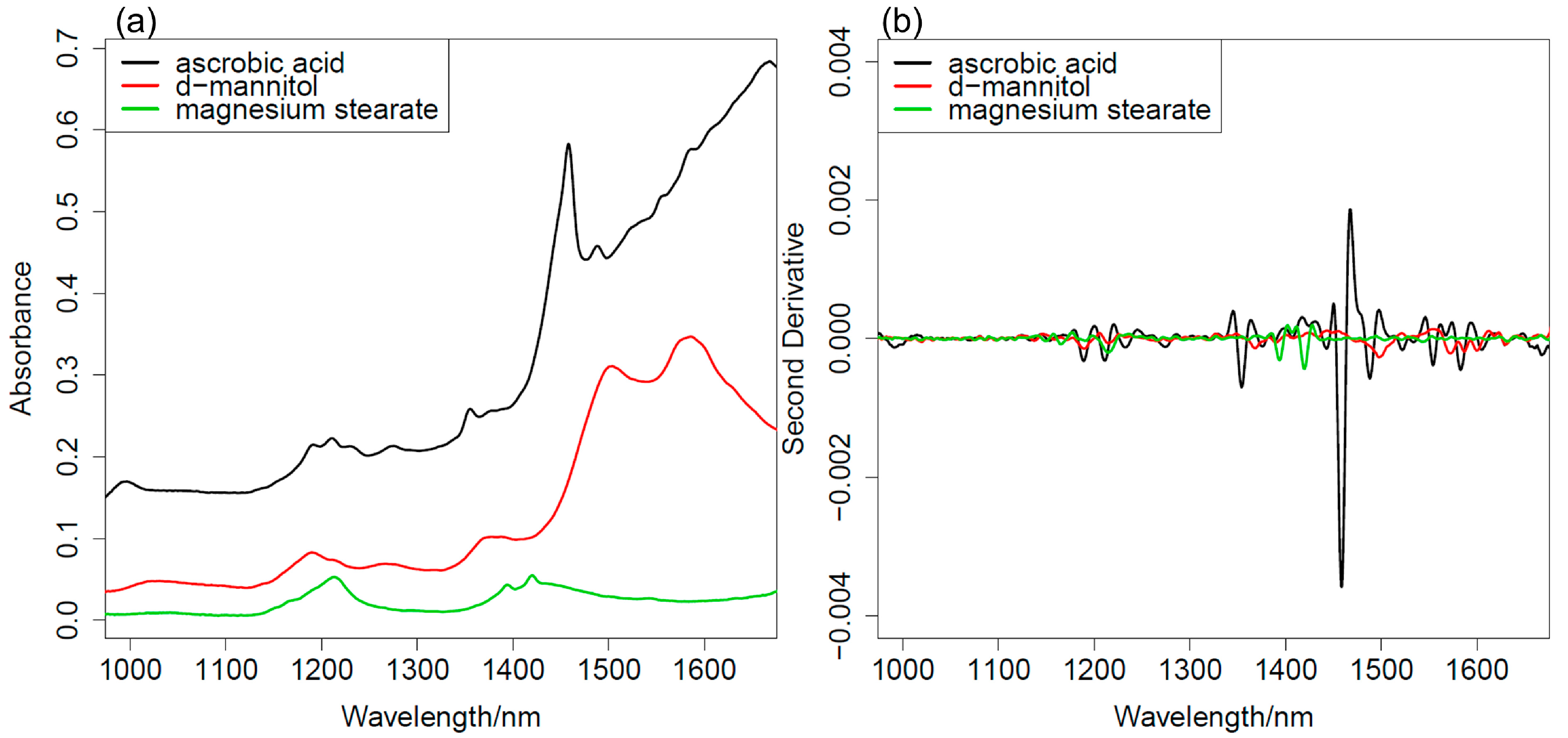
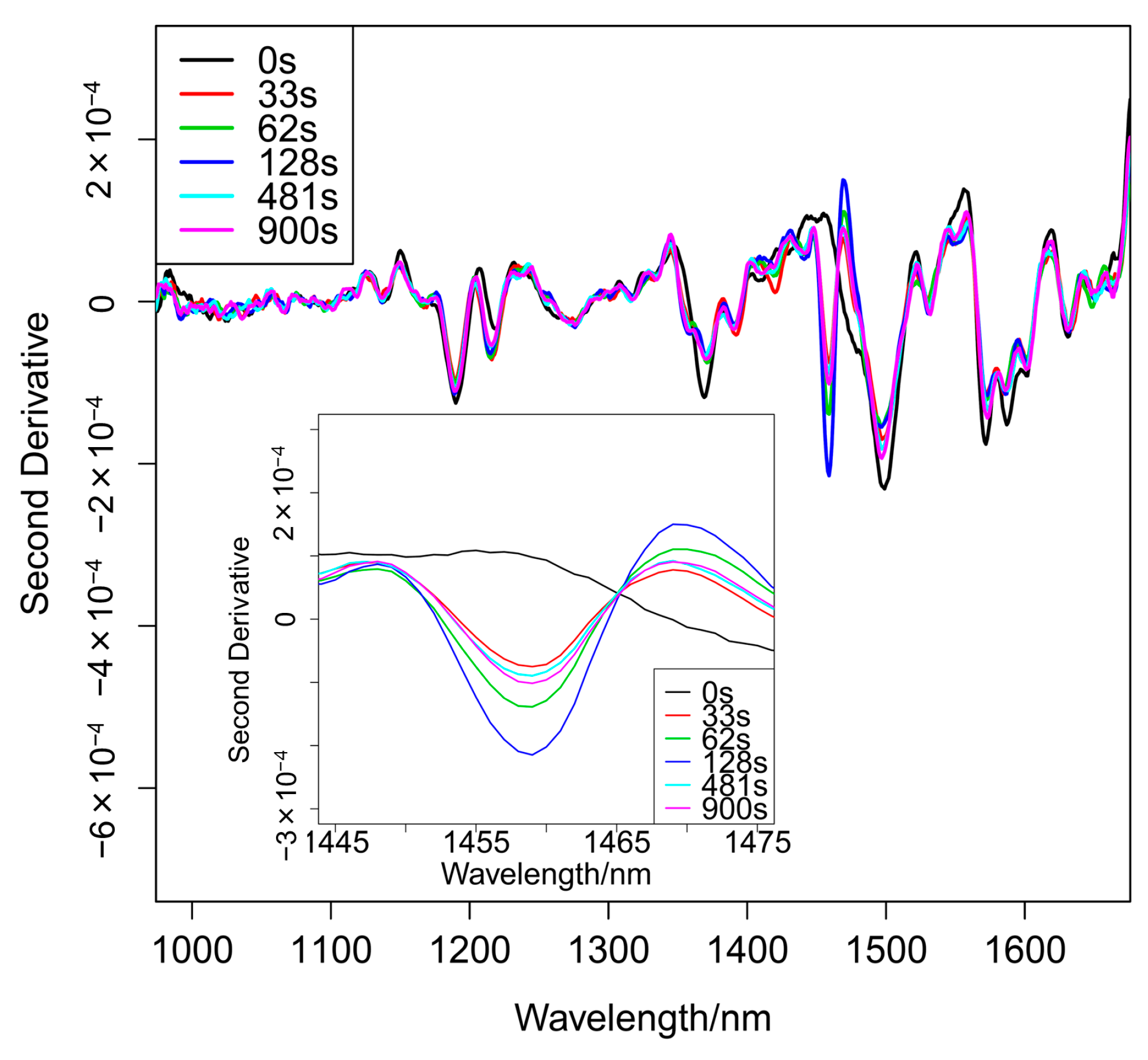

2.3. Evaluation of Inhomogeneity during Blending Process by NIR Imaging
| Measurement Area | 5 mm × 5 mm | |||
|---|---|---|---|---|
| Spatial Resolution | 1 mm | 0.5 mm | 0.2 mm | 0.1 mm |
| Number of Measurement Point (Number of Spectra Data) | 36 | 121 | 676 | 2061 |
| Measurement Time | 5 s | 13 s | 64 s | 242 s |



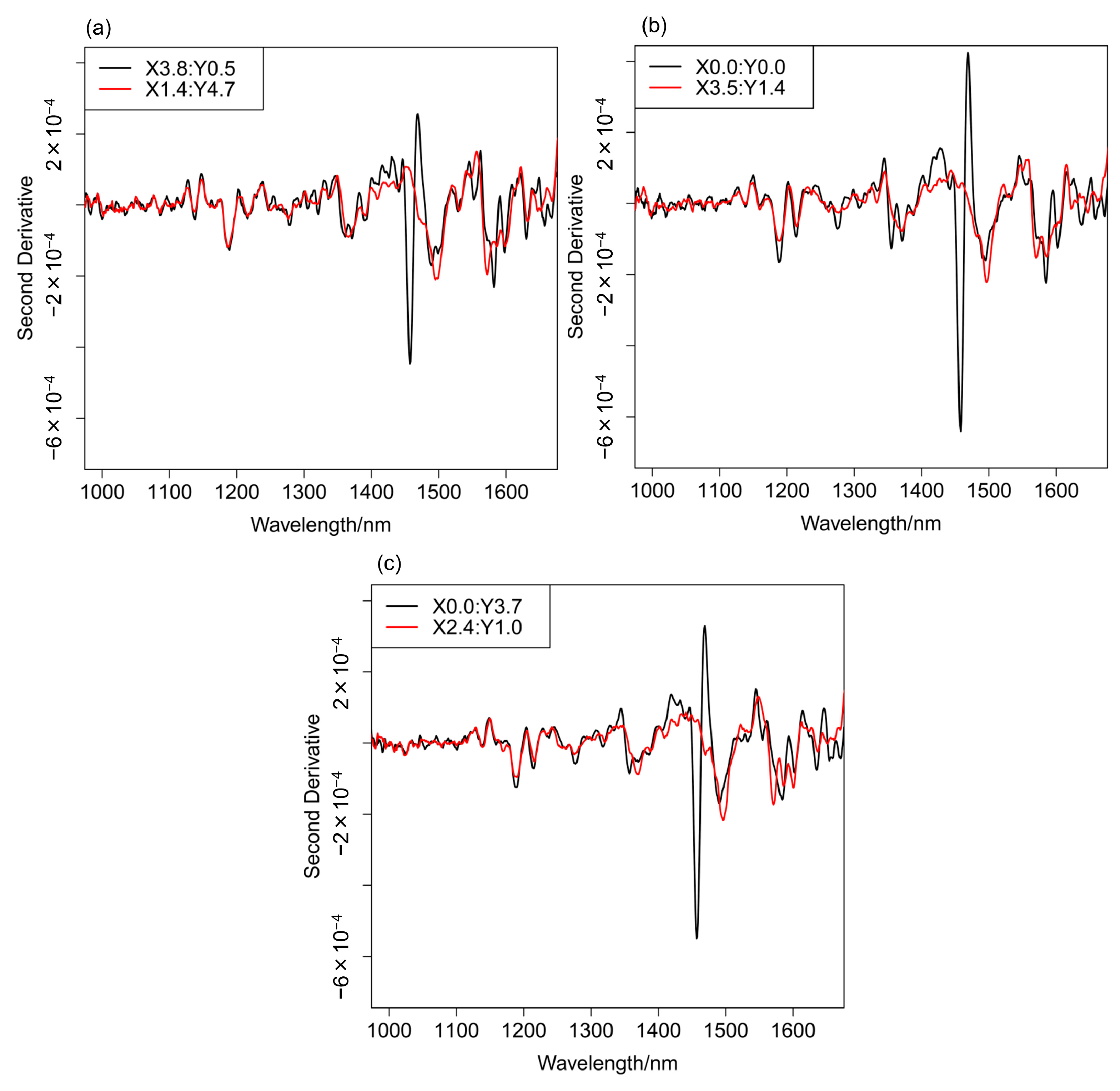
3. Experimental Section
3.1. New NIR Imaging Device (ND-NIRs)
3.2. Data Collection

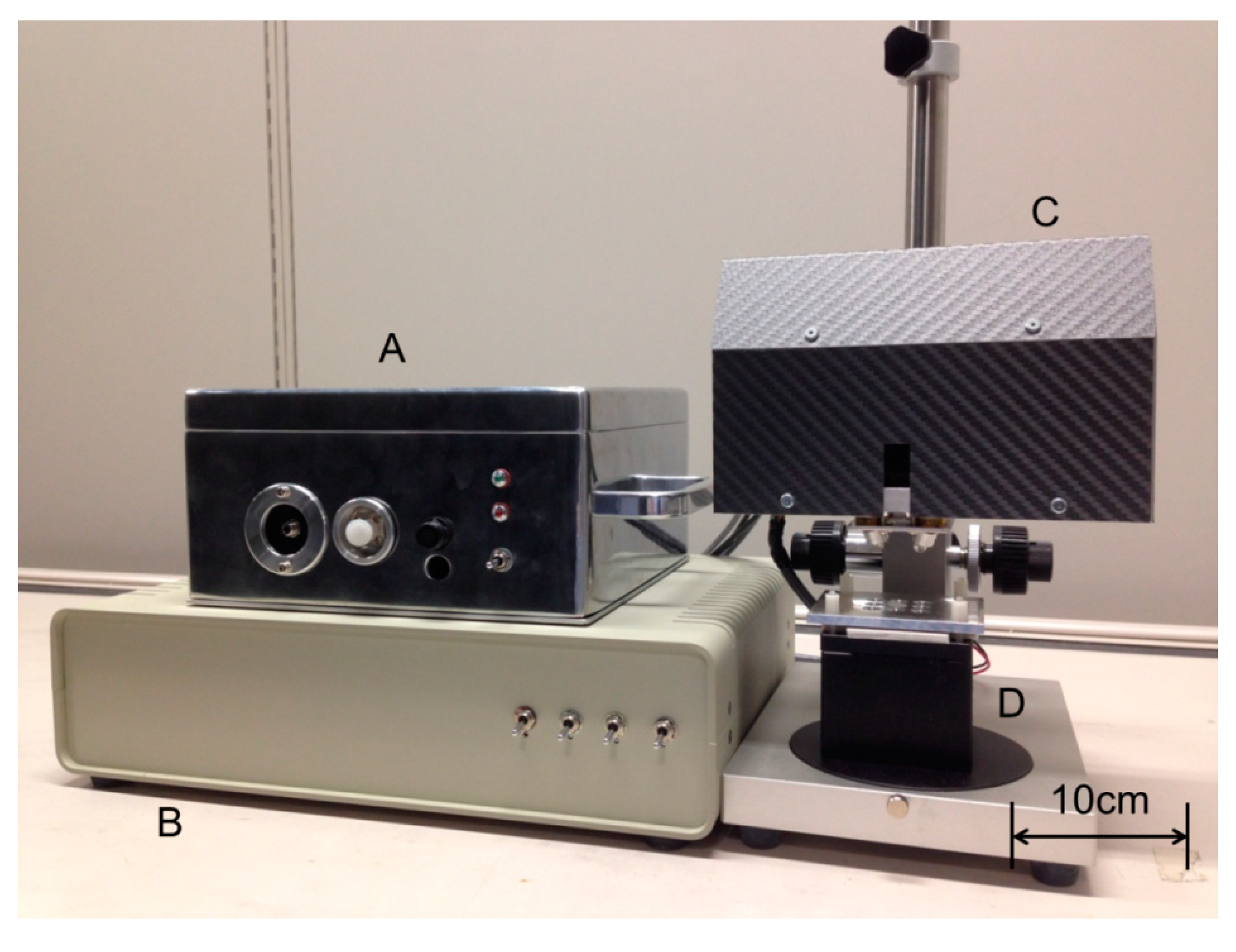
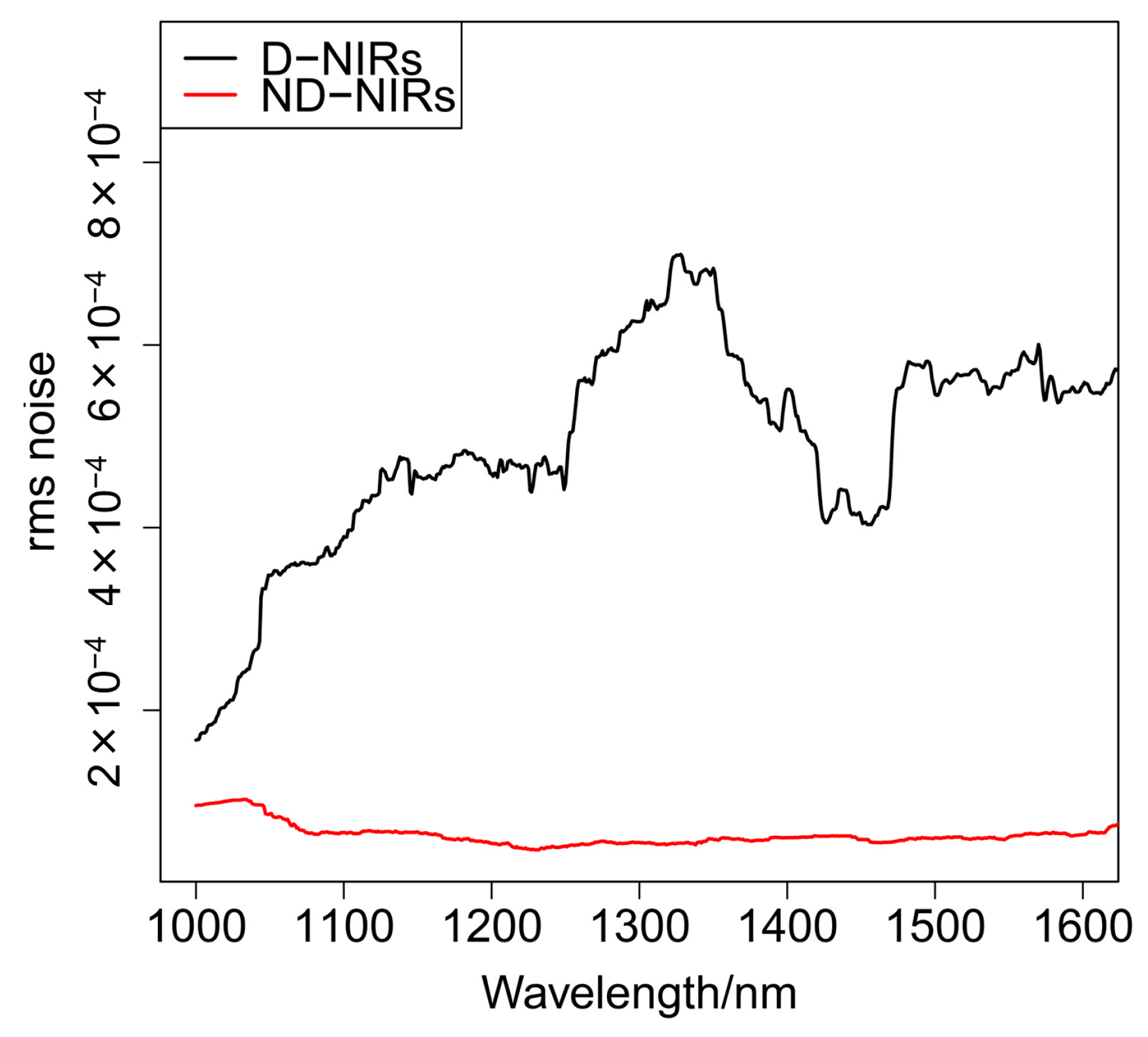
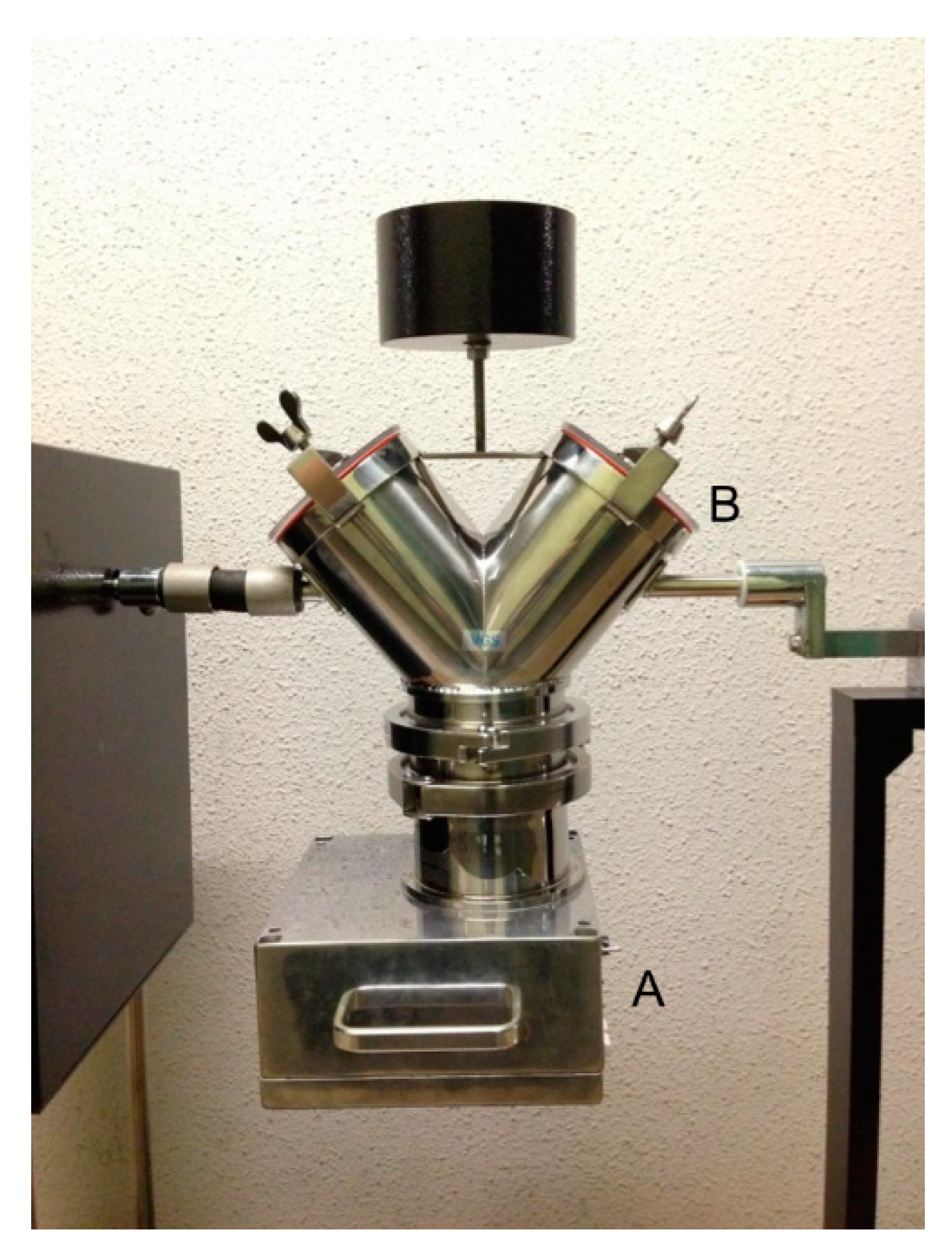
3.3. Sample Preparation
4. Conclusions
Acknowledgments
Author Contributions
Conflicts of Interest
References
- International Conference on Harmonisation of Technical Requirements for Registration of Pharmaceuticals for Human Use. ICH Harmonized Tripartite Guideline Pharmaceutical Development Q8 (R2). Available online: http://www.ich.org/fileadmin/Public_Web_Site/ICH_Products/Guidelines/Quality/Q8_R1/Step4/Q8_R2_Guideline.pdf (accessed on 15 January 2015).
- US Food Drug Administration. Guidance for Industry, PAT: A Framework for Innovative Pharmaceutical Development, Manufacturing, and Quality Assurance. Available online: http://www.fda.gov/downloads/Drugs/Guidances/ucm070305.pdf (accessed on 15 January 2015).
- Bakeev, K.A. Process Analytical Technology, 1st ed.; Blackwell Publishing: Oxford, UK, 2005; pp. 13–38. [Google Scholar]
- Ozaki, Y.; Amari, T. Near-Infrared Spectroscopy in Chemical Process Analysis; Sheffield Academic Press: Sheffield, UK, 2000; pp. 53–95. [Google Scholar]
- Andersson, M.; Folestad, S.; Gottfries, J.; Johansson, M.O.; Josefson, M.; Wahlund, K.G. Quantitative analysis of film coating in a fluidized bed process by in-line NIR spectrometry and multivariate batch calibration. Anal. Chem. 2000, 72, 2099–2108. [Google Scholar] [CrossRef] [PubMed]
- Kogermann, K.; Aaltonen, J.; Strachan, C.J.; Pollanen, K.; Heinamaki, J.; Yliruusi, J.; Rantanen, J. Establishing quantitative in-line analysis of multiple solid state transformations during dehydration. J. Pharm. Sci. 2008, 97, 4983–4999. [Google Scholar] [CrossRef] [PubMed]
- Li, W.; Worosila, G.D.; Wang, W.; Mascaro, T. Determination of polymorph conversion of an active pharmaceutical ingredient in wet granulation using NIR calibration models generated from the premix blends. J. Pharm. Sci. 2005, 94, 2800–2806. [Google Scholar] [CrossRef] [PubMed]
- Trafford, A.D.; Jee, R.D.; Moffatand, A.C.; Graham, P. A rapid quantitative assay of intact paracetamol tablets by reflectance near-infrared spectroscopy. Analyst 1999, 124, 163–167. [Google Scholar] [CrossRef] [PubMed]
- Rantanen, J.; Räsänen, E.; Tenhunen, J.; Känsäkoski, M.; Mannermaa, J.P.; Yliruusi, J. In-line moisture measurement during granulation with a four-wavelength near infrared sensor: An evaluation of particle size and binder effect. Eur. J. Pharm. Biopharm. 2000, 50, 271–276. [Google Scholar] [CrossRef] [PubMed]
- Sekulic, S.S.; Ward, H.W., II; Brannegan, D.R.; Stanley, E.D.; Evans, C.L.; Sciavolino, S.T.; Hailey, P.A.; Aldridge, P.K. On-Line Monitoring of Powder Blend Homogeneity by Near-Infrared Spectroscopy. Anal. Chem. 1996, 68, 509–513. [Google Scholar] [CrossRef] [PubMed]
- El-Hagrasy, A.S.; Delgado-Lopez, M.; Drennen, J.K., III. A Process Analytical Technology approach to near-infrared process control of pharmaceutical powder blending: Part II: Qualitative near-infrared models for prediction of blend homogeneity. J. Pharm. Sci. 2006, 95, 407–421. [Google Scholar] [CrossRef] [PubMed]
- Ozaki, Y. Near-infrared spectroscopy—Its versatility in analytical chemistry. Anal. Sci. 2012, 28, 545–563. [Google Scholar] [CrossRef] [PubMed]
- Šašić, S.; Ozaki, Y. Raman, Infrared, and Near-Infrared Chemical Imaging; John Wiley & Sons Ltd.: Hoboken, NJ, USA, 2009. [Google Scholar]
- Shinzawa, H.; Awa, K.; Ozaki, Y. Compression induced morphological and molecular structural changes of cellulose tablets probed with near infrared imaging. J. Near Infrared Spectrosc. 2011, 19, 15–22. [Google Scholar] [CrossRef]
- Ishikawa, D.; Murayama, K.; Genkawa, T.; Awa, K.; Komiyama, M.; Ozaki, Y. Development of compact near infrared imaging device with high-speed and portability for pharmaceutical process monitoring. NIR News 2012, 23, 14–17. [Google Scholar] [CrossRef]
- Unger, M.; Ozaki, Y.; Siesler, H.W. Variable-Temperature Fourier Transform Near-Infrared (FT-NIR) Imaging Spectroscopy of the diffusion process of Butanol (OD) into Polyamide 11. Appl. Spectrosc. 2011, 65, 1051–1055. [Google Scholar] [CrossRef] [PubMed]
- Neil Lewis, E.; Schoppelrei, J.; Lee, E. Near-infrared Chemical Imaging and the PAT Initiative-NIR-CI adds a completely new dimension to conventional NIR spectroscopy. Spectroscopy 2004, 19, 26–36. [Google Scholar]
- Gao, P.; Meury, R.H. Swelling of hydroxypropyl methylcellulose matrix tablets. 1. Characterization of swelling using a novel optical imaging method. J. Pharm. Sci. 1996, 85, 725–731. [Google Scholar] [CrossRef] [PubMed]
- Ishikawa, D.; Murayama, K.; Genkawa, T.; Awa, K.; Komiyama, M.; Sergei, K.; Ozaki, Y. Application of a newly developed portable NIR imaging device to dissolution process monitoring of tablets. Anal. Bioanal. Chem. 2013, 405, 9401–9409. [Google Scholar] [CrossRef] [PubMed]
- Murayama, K.; Genkawa, T.; Ishikawa, D.; Komiyama, M.; Ozaki, Y. A polychromator-type near-infrared spectrometer with a high-sensitivity and high-resolution photodiode array detector for pharmaceutical process monitoring on the millisecond time scale. Rev. Sci. Instrum. 2013, 84, 023104. [Google Scholar] [CrossRef] [Green Version]
- Ishikawa, D.; Genkawa, T.; Murayama, K.; Komiyama, M.; Ozaki, Y. Feasibility study of diffuse reflectance and transmittance near infrared spectroscopy for rapid analysis of ascorbic acid concentration in bilayer tablets using a high-speed polychromator-type spectrometer. J. Near Infrared Spectrosc. 2014, 22, 189–197. [Google Scholar] [CrossRef]
- Otsuka, M.; Tanabe, H.; Osaki, K.; Otsuka, K.; Ozaki, Y. Chemoinformetrical Evaluation of Dissolution Property of Indomethacin Tablets by Near-Infrared Spectroscopy. J. Pharm. Sci. 2007, 96, 788–801. [Google Scholar] [CrossRef] [PubMed]
- Van der Weerd, J.; Kazarian, S.G. Combined approach of FTIR imaging and conventional dissolution tests applied to drug release. J. Control. Release 2004, 98, 295–305. [Google Scholar] [CrossRef] [PubMed]
- Kazarian, S.G.; van der Weerd, J. Simultaneous FTIR Spectroscopic Imaging and Visible Photography to Monitor Tablet Dissolution and Drug Release. Pharm. Res. 2004, 25, 853–860. [Google Scholar] [CrossRef]
- Ufret, C.; Morris, K. Modeling of powder blending using on-line near infrared measurements. Drug Dev. Ind. Pharm. 2001, 27, 719–729. [Google Scholar] [CrossRef] [PubMed]
- Li, W.; Woldu, A.; Kelly, R.; McCool, J.; Bruce, R.; Rasmussen, H.; Cunningham, J.; Winstead, D. Measurement of drug agglomerates in powder blending simulation samples by near infrared chemical imaging. Int. J. Pharm. 2008, 350, 369–373. [Google Scholar] [CrossRef] [PubMed]
- El-Hagrasy, A.S.; Morris, H.R.; D’amico, F.; Lodder, R.A.; Drennen, J.K., III. Near-Infrared Spectroscopy and Imaging for the Monitoring of Powder Blend Homogeneity. J. Pharm. Sci. 2001, 90, 1298–1307. [Google Scholar] [CrossRef] [PubMed]
- Lui, H.; Xiang, B.; Qu, L. Structure analysis of ascorbic acid using near-infrared spectroscopy and generalized two dimensional correlation spectroscopy. J. Mol. Struct. 2006, 794, 12–17. [Google Scholar] [CrossRef]
- Cogdill, R.P.; Anderson, C.A.; Delgado-Lopez, M.; Molseed, D.; Chisholm, R.; Bolton, R.; Herkert, T.; Afnan, A.M.; Drennen, J.K., III. Process Analytical Technology Case Study Part I: Feasibility Studies for Quantitative Near-Infrared Method Development. AASP Pharm. Sci. Tech. 2005, 6, 262–272. [Google Scholar] [CrossRef]
- Savitzky, A.; Golay, M.J.E. Smoothing and differentiation of data by simplified least squares procedures. J. Anal. Chem. 1964, 36, 1627–1639. [Google Scholar] [CrossRef]
- Sample Availability: Not available.
© 2015 by the authors. Licensee MDPI, Basel, Switzerland. This article is an open access article distributed under the terms and conditions of the Creative Commons Attribution license ( http://creativecommons.org/licenses/by/4.0/).
Share and Cite
Murayama, K.; Ishikawa, D.; Genkawa, T.; Sugino, H.; Komiyama, M.; Ozaki, Y. Image Monitoring of Pharmaceutical Blending Processes and the Determination of an End Point by Using a Portable Near-Infrared Imaging Device Based on a Polychromator-Type Near-Infrared Spectrometer with a High-speed and High-Resolution Photo Diode Array Detector. Molecules 2015, 20, 4007-4019. https://doi.org/10.3390/molecules20034007
Murayama K, Ishikawa D, Genkawa T, Sugino H, Komiyama M, Ozaki Y. Image Monitoring of Pharmaceutical Blending Processes and the Determination of an End Point by Using a Portable Near-Infrared Imaging Device Based on a Polychromator-Type Near-Infrared Spectrometer with a High-speed and High-Resolution Photo Diode Array Detector. Molecules. 2015; 20(3):4007-4019. https://doi.org/10.3390/molecules20034007
Chicago/Turabian StyleMurayama, Kodai, Daitaro Ishikawa, Takuma Genkawa, Hiroyuki Sugino, Makoto Komiyama, and Yukihiro Ozaki. 2015. "Image Monitoring of Pharmaceutical Blending Processes and the Determination of an End Point by Using a Portable Near-Infrared Imaging Device Based on a Polychromator-Type Near-Infrared Spectrometer with a High-speed and High-Resolution Photo Diode Array Detector" Molecules 20, no. 3: 4007-4019. https://doi.org/10.3390/molecules20034007





